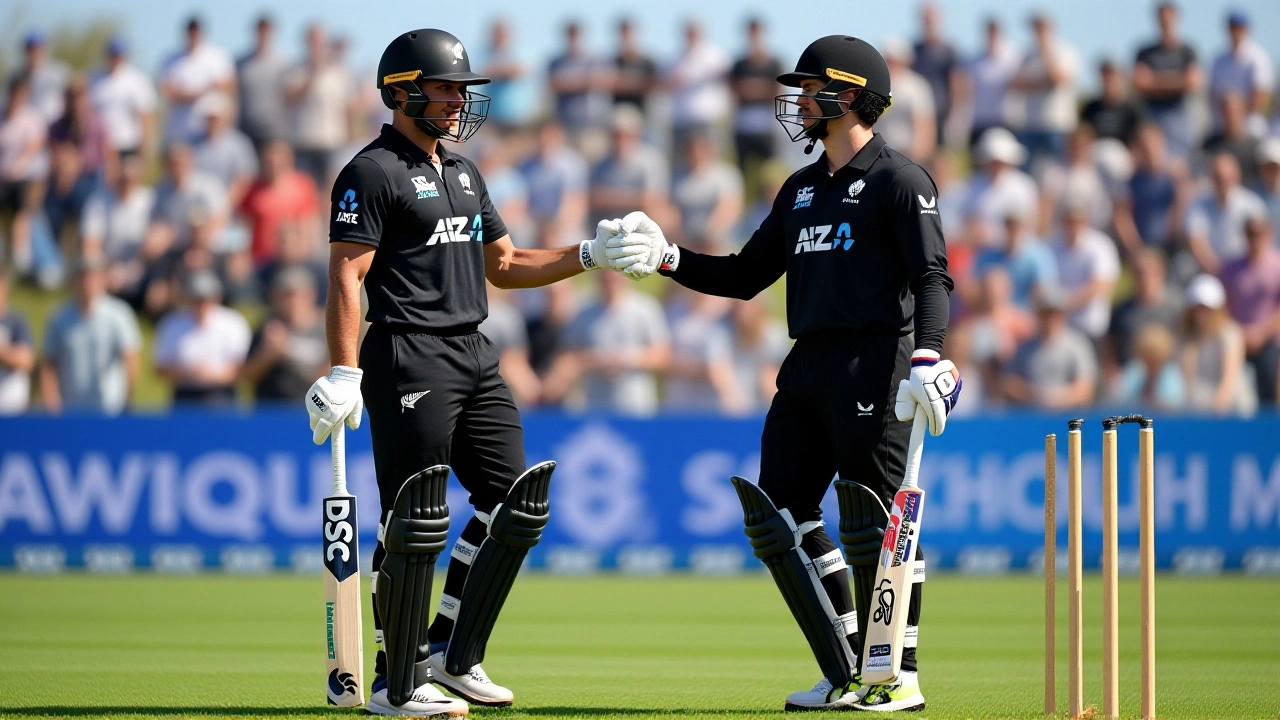New Zealand delivered a masterclass in controlled aggression and disciplined bowling to beat Sri Lanka by 113 runs in the 2nd ODI at Seddon Park on January 8, 2025, sealing an unassailable 2-0 lead in their three-match series. The win wasn’t just about runs or wickets—it was about timing, pressure, and execution under lights, with captain Mitchell Santner claiming his first ODI series victory as full-time skipper. Sri Lanka, already reeling from a 72-run loss in the opener, collapsed under the weight of poor shot selection, costly run-outs, and relentless seam pressure. The final scorecard told a brutal story: 255/9 in 37 overs by New Zealand versus 142 all out in 30.2 overs by Sri Lanka. It wasn’t a fluke. It was a statement.
A Batting Performance Built on Patience and Power
New Zealand didn’t go for broke. They built. Rachin Ravindra and Mark Chapman laid the foundation with a 100-run partnership that felt like a masterclass in modern ODI batting. Ravindra’s 79 off 63 balls (SR 125.39) had rhythm, while Chapman’s 62 off 52 (SR 119.23) was pure intent. Both brought up their fifties with sixes—no fluke, no luck, just precision. The middle order didn’t collapse when the Power Play 3 (overs 30–37) saw five wickets fall for 44 runs. That’s not panic. That’s calculated risk. They knew 255 was enough. And they were right.Bowling That Broke Sri Lanka’s Spirit
If the batting was disciplined, the bowling was surgical. William O’Rourke led the charge with 3/31 in 6.2 overs, hitting the hard length with unnerving consistency. Matt Henry and Jacob Duffy added 1 and 2 wickets respectively, keeping the pressure on. But the real story? The bounce. The swing. The way the ball came off the pitch like a live wire. Santner, who took 1/14 in 5 overs, said it best: “The seamers hit the hard length and made it hard for the batters. It usually swings under lights—and they extracted the bounce, bashed the hard length time and again.”Sri Lanka’s innings never recovered. Kamindu Mendis, their lone bright spot with 64 off 66, was stranded. The rest? A procession. Pathum Nissanka out for 1. BKG Mendis for 2. KIC Asalanka for 4. C Wickramasinghe for 17. Four run-outs. Four moments of self-destruction. ESPN called it “disastrous.” The commentary team at Hindustan Times said it was “yet another disappointing show.” And they weren’t wrong.

The Hat-Trick That Didn’t Save the Day
Let’s talk about Maheesh Theekshana. The Sri Lankan spinner took 4/44 in 8 overs—the best figures on the losing side. He even took a hat-trick, according to ESPN. But here’s the twist: it came too late. With Sri Lanka already at 67/7, the hat-trick was a statistical footnote, not a turning point. Theekshana’s brilliance was drowned in the chaos of poor batting, reckless running, and a New Zealand fielding unit that looked like it had trained for this moment. Even the extras told the story: 10 wides and a leg bye. That’s not bad luck. That’s poor execution.What This Means for the Series and Beyond
This isn’t just about a 2-0 lead. It’s about momentum. New Zealand, ranked 5th in ODIs, are now the clear favorites heading into the 2025 World Cup. Santner’s leadership has matured. The seamers are firing. The middle order is stable. Meanwhile, Sri Lanka—the 2023 World Cup semi-finalists—are unraveling. Their batting has no spine. Their fielding is sloppy. Their spinners are overworked. And now, with one game left, they’re playing for pride. Not for points. Not for progress. Just to avoid a whitewash.There’s a deeper narrative here. New Zealand’s win at Seddon Park mirrors their rise under Santner: quiet, consistent, built on fundamentals. Sri Lanka, by contrast, still rely on individual brilliance rather than team structure. That’s why they keep losing tight games. That’s why they keep falling short.

What’s Next?
The 3rd and final ODI takes place on January 11 at the same venue. New Zealand will aim for a clean sweep, while Sri Lanka will hope for a spark—any spark. But given the momentum, the form, and the confidence of the home side, a win for Sri Lanka feels like a long shot. Even if they win, the damage is done. The message has been sent: New Zealand aren’t just competitive. They’re dangerous.Frequently Asked Questions
How did New Zealand’s seamers dominate despite the pitch not being traditionally seaming?
Despite Seddon Park’s reputation for being a balanced batting track, New Zealand’s bowlers exploited the evening conditions perfectly. The ball swung in the air under lights, and the hard length forced Sri Lankan batters into false shots. O’Rourke and Henry consistently targeted the corridor outside off-stump, making it impossible to score freely without risking edges. The pitch offered just enough bounce to keep the batters guessing, turning what looked like a flat surface into a death trap.
Why were Sri Lanka’s run-outs so damaging?
Sri Lanka lost four batters to run-outs, all occurring in the first 20 overs when they were trying to accelerate. These weren’t misjudgments—they were panicked decisions. With the scoreboard already under pressure, batters rushed between wickets without checking with their partners. Each dismissal broke momentum and demoralized the team. By the time Kamindu Mendis was batting well, Sri Lanka were already 67/7. Run-outs aren’t just statistical errors—they’re psychological blows.
Is this the first time Mitchell Santner has won an ODI series as captain?
Yes. While Santner has captained New Zealand in limited-overs matches before, this is his first full ODI series win as the designated captain. He previously led in the absence of regular skipper Kane Williamson, but this series marks his first time leading the team through a full three-match series with consistent results. His calm demeanor and tactical use of spinners and seamers have earned praise from former players like Daniel Vettori.
What impact does this result have on New Zealand’s World Cup prospects?
This win significantly boosts New Zealand’s confidence ahead of the 2025 ICC Cricket World Cup. Their top four is now firing, the middle order is resilient, and their pace attack has proven it can dominate under pressure. With Santner’s leadership stabilizing the unit and players like O’Rourke and Henry emerging as key performers, New Zealand are no longer just dark horses—they’re genuine contenders. Their ability to win low-scoring games and chase tough totals makes them one of the most balanced teams in the tournament.
How does Sri Lanka’s performance compare to their 2023 World Cup campaign?
In 2023, Sri Lanka reached the semi-finals with explosive batting and clever spin. Now, they’re losing by over 100 runs in home conditions. The same batters who scored centuries in India are getting out to poor shots. The spinners are being targeted relentlessly. Their fielding, once sharp, is now erratic. The contrast is stark: back then, they played with belief. Now, they play with anxiety. Without structural changes in selection and coaching, their decline could continue.
What role did the venue, Seddon Park, play in the match outcome?
Seddon Park, known for its balanced conditions, actually favored New Zealand’s style. The outfield is quick, allowing fielders to cut off boundaries. The pitch retained just enough moisture to assist seam movement early and late. Crucially, the evening dew didn’t come into play, which meant the ball didn’t get too slippery for the bowlers. New Zealand’s strategy to bowl tight lines under lights exploited this perfectly. For Sri Lanka, the familiar conditions made their failures even more inexplicable.

